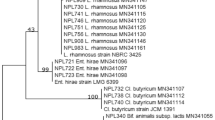Abstract
Probiotic supplements can contribute to maintaining health and ameliorating various disease symptoms. Probiotics can be delivered in many forms with crucial differences in their survival during gastrointestinal (GI) passage. Previously, a novel encapsulation, Probiotic Pearls™ Acidophilus, Integrative Therapeutics, LLC, USA (Pearls), was shown to increase survival in vitro after exposure to gastric conditions. Here, we compare fecal recovery in human volunteers consuming Pearls or a conventional hard-shelled gelatin capsule. We performed a randomized double-blinded, two-armed trial, with six healthy subjects in each 12-day study arm. In fecal samples collected at baseline, twice during the intervention period, and after washout, we compared colony counts between the two encapsulation methods. The identity of the colonies was confirmed by colony morphology, strain-specific PCR, and 16S rRNA gene sequencing. We further performed a comprehensive 16S rRNA gene sequencing-based analysis to identify differential effects on overall microbiota composition. We detected an average log increase in bifidobacteria of 0.152 cfu/g with gelatin and 0.651 cfu/g with Pearls capsules (p > 0.05). Total lactobacilli counts increased in both groups with no difference between the groups. However, the supplemented Lactobacillus acidophilus NCFM decreased to baseline levels within 7 days after end of supplementation with gelatin capsules while 3.11 log cfu/g higher counts compared to baseline (p = 0.05) remained for Pearls. Targeted qPCR largely confirmed the trends observed by viable plate counts. Protecting the probiotic strains by Pearls encapsulation results in higher recovery rates of the supplemented lactobacilli and bifidobacteria in fecal samples and increased persistence, suggesting an improved survival and viability that might increase efficacy towards achieving desired health benefits.

Similar content being viewed by others
Reference
Brinig M-M, Lepp P-W, Ouverney C-C, Armitage G-C, Relman D-A (2003) Prevalence of bacteria of division TM7 in human subgingival plaque and their association with disease. Appl Environ Microbiol 69:1687–1694
Costello E-K, Lauber C-L, Hamady M, Fierer N, Gordon J-I, Knight R (2009) Bacterial community variation in human body habitats across space and time. Science 326:1694–1697
Caporaso JG, Kuczynski J, Stombaugh J, Bittinger K, Bushman FD, Costello EK, Knight R (2010) QIIME allows analysis of high-throughput community sequencing data. Nat Methods 7(5):335–336
Eckburg P-B, Bik E-M, Bernstein C-N, Purdom E, Dethlefsen L, Sargent M (2005) Diversity of the human intestinal microbial flora. Science 308:1635–1638
Flint H-J, Scott K-P, Louis P, Duncan S-H (2012) The role of the gut microbiota in nutrition and health. Nat Rev Gastroenterol Hepatol 9:577–589
Hooper L-V, Gordon J-I (2001) Commensal host-bacterial relationships in the gut. Science 292:1115–1118
Kuehbacher T, Rehman A, Lepage P, Hellmig S, Folsch U-R, Schreiber S, Ott S-J (2008) Intestinal TM7 bacterial phylogenies in active inflammatory bowel disease. J Med Microbiol 57:1569–1576
Mai V, Colbert LH, Perkins SN, Schatzkin A, Hursting SD (2007) Intestinal microbiota: a potential diet-responsive prevention target in ApcMin mice. Mol Carcinog 46:42–48
Mai V, McCrary Q-M, Sinha R, Glei M (2009) Associations between dietary habits and body mass index with gut microbiota composition and fecal water genotoxicity: an observational study in African American and Caucasian American volunteers. Nutr J 8:49
Pace N-R, Olsen G-J, Woese C-R (1986) Ribosomal RNA phylogeny and the primary lines of evolutionary descent. Cell 45:325–326
Pylro VS, Roesch LFW, Morais DK, Clark IM, Hirsch PR, Tótola MR (2014) Data analysis for 16S microbial profiling from different benchtop sequencing platforms. J Microbiol Methods 107:30–37
Savage D-C (2012) Microbial ecology of the gastrointestinal tract. Annu Rev Microbiol 31:107–133
Sekirov I, Finlay B-B (2009) The role of the intestinal microbiota in enteric infection. J Physiol 587:4159–4167
Sokol H, Seksik P, Furet J-P, Firmesse O, Nion-Larmurier I, Beaugerie L (2009) Low counts of Faecalibacterium prausnitzii in colitis microbiota. Inflamm Bowel Dis 15:1183–1189
Sokol H, Seksik P, Rigottier-Gois L, Lay C, Lepage P, Podglajen I (2006) Specificities of the fecal microbiota in inflammatory bowel disease. Inflamm Bowel Dis 12:106–111
Swidsinski A, Loening-Baucke V, Lochs H, Hale L-P (2005) Spatial organization of bacterial flora in normal and inflamed intestine: a fluorescence in situ hybridization study in mice. World J Gastroenterol 11:1131–1140
Swidsinski A, Loening-Baucke V, Theissig F, Engelhardt H, Bengmark S, Koch S (2007) Comparative study of the intestinal mucus barrier in normal and inflamed colon. Gut 56:343–350
Swidsinski A, Loening-Baucke V, Vaneechoutte M, Doerffel Y (2008) Active Crohn’s disease and ulcerative colitis can be specifically diagnosed and monitored based on the biostructure of the fecal flora. Inflamm Bowel Dis 14:147–161
Terzic J, Grivennikov S, Karin E, Karin M (2010) Inflammation and colon cancer. Gastroenterology 138:2101–U119
Tremaroli V, Backhed F (2012) Functional interactions between the gut microbiota and host metabolism. Nature 489:242–249
Acknowledgments
We would like to thank the volunteers that participated in the study. The study was funded by Schwabe NA.
Author information
Authors and Affiliations
Corresponding author
Ethics declarations
Funding
This study was funded by Schwabe NA.
Conflict of interest
All authors declare that they have no conflict of interest.
Ethical approval
All procedures performed in studies involving human participants were in accordance with the ethical standards of the institutional and/or national research committee and with the 1964 Helsinki declaration and its later amendments or comparable ethical standards.
Informed consent
Informed consent was obtained from all individual participants included in the study under a protocol approved by UF IRB01.
Rights and permissions
About this article
Cite this article
Mai, V., Waugh, S., Byrd, D. et al. Novel encapsulation improves recovery of probiotic strains in fecal samples of human volunteers. Appl Microbiol Biotechnol 101, 1419–1425 (2017). https://doi.org/10.1007/s00253-016-7915-8
Received:
Revised:
Accepted:
Published:
Issue Date:
DOI: https://doi.org/10.1007/s00253-016-7915-8




